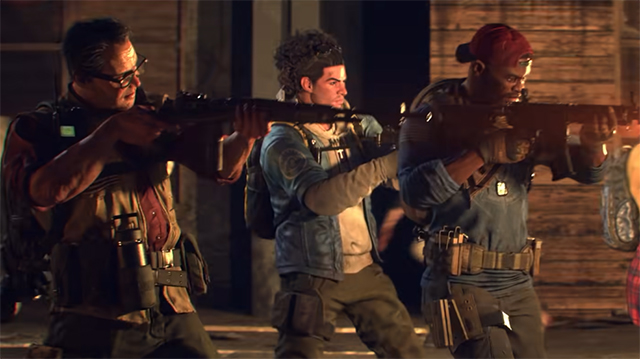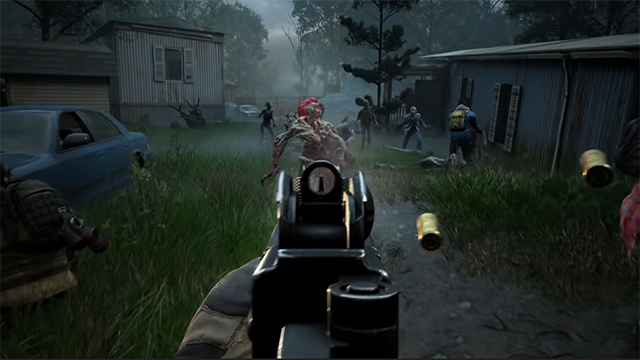There’s no shortage of co-op shooters from Payday to GTFO to the multiple games Rebellion pushes out every couple of years or so. These types of experiences are popular because they serve as non-competitive ways to virtually socialize, a comfort that has only grown in popularity because of the ongoing pandemic. Turtle Rock Studios is coincidentally blending together viruses and co-op shooters with Back 4 Blood. And it’s not just cashing in on a trend as it is shaping up to be one of the stronger co-op shooters in recent years and the refresh that this genre needs.
A lot of this has to do with its legacy, which can’t be ignored. Turtle Rock, under its Valve South moniker, created Left 4 Dead, the game mostly responsible for this breed of cooperative shooter. The name alone implies the connection that’s made significantly stronger by the gameplay and presentation. Four players travel through some type of multi-stage level with safehouses breaking up the hordes of hostiles.

That familiar top-level description acts as shorthand and allows the game to focus on the details, which is where it flourishes. Many of said details are primarily focused on creating a unique experience that shows itself in obvious and subtle ways. The Director from Left 4 Dead shows up here yet again and has the same role: constantly assess the situation and create a unique, challenging, and fitting scenario.
It’s difficult to pinpoint exactly what it does in the moment while evading a bloody grave. There does seem to be a constant sense of pressure yet it’s tricky to quantify. The variation won’t even be apparent until players replay levels multiple times. But given the effectiveness of this defining system in Left 4 Dead, Turtle Rock has earned some benefit of the doubt in this area.

The team is also pushing forward with this effort towards variability and putting it in the hands of the players. Players are able to make decks of cards and then are prompted to choose three from at the start of a chapter and then one additional one before starting the next section. There are an absolute ton of them and they range from more health, additional stamina, chances to find better gear, and the like and are welcome ways to further customize the experience.
However, corruption cards are much more interesting because they affect enemy behavior and more noticeably alter the experience. They can add fog to make it harder to see, litter the level with Snitchers to make impromptu stealth sections, or even have special objectives that yield extra rewards upon completion. Changing the game so visibly and letting the players drive that change is an excellent evolution of the formula and these corruption cards seem like they might be the secret part of the sauce here.
There are still other parts of the sauce, too, like character customization. Each of the eight Cleaners have explicitly stated different attributes as well as distinct identities. Like the cards, each yields a small stat boost and, given how many there are, can easily fit within someone’s playstyle. Their personalities also appeared to be tolerable and engaging without going overboard and being too quippy or annoying. Multiple sessions and dozens of hours could disprove that, but given how beloved the Left 4 Dead survivors are, it’s not as likely.

All of this would be for naught if the game didn’t actually play well, which is where a lot of entries in this genre fall short. Whether it is a game like Zombie Army or what will likely be the upcoming Aliens: Fireteam Elite, some entries in this co-op shooter genre just feel and look a little off. Many of these games are budget titles and it shows.
But Back 4 Blood doesn’t control like a budget game (it is a full-priced release, after all) nor does it look like a dated shooter from 2013. It has relatively modern visuals that don’t look cheap or stilted. The beta didn’t run perfectly on PC, but it was playable and Turtle Rock still has a few months to optimize everything.
This suboptimal pre-release performance didn’t kill the shooting as it still had some heft to it; a result of the wonderful mix of sound design, weapon animation, and general responsiveness. There are also a ton of mods and attachments that players can equip to further beef up their firearms. With or without these enhancements, it doesn’t sound or look like players are shooting peas or soft carrots at the infected. And since players will be constantly firing rounds with little to do in between, it’s important that the gunplay is as good as it is. It is a little annoying that getting damaged significantly slows down players, but at least the controls are there to appropriately fend them off.

Back 4 Blood gives players a fair bit of monsters — called Ridden — to test these guns on. There are the typical array of grunts, but these are just there to overwhelm and pressure players when dealing with the bigger threats. There are four special types of Ridden that all fill different roles that range from alerting the hoard, binding players, grabbing them, and exploding near them. A few of them have unique variants, as well. Admittedly, all four have a Left 4 Dead parallel, but they still work because they force players to stay on their toes and work together.
There are even larger Ridden and, even though it’s an amazing foundation, it’s where Back 4 Blood starts to deviate from its roots and break some new ground. While a bit like L4D’s Tank, the Ogre is huge and brings a whole new sense of scale to this co-op shooter. There are other boss-scale monsters seen in the game’s promotional material like the Hag that can instakill players, a giant wavy worm, an armor-covered Breaker, and the absolutely massive and unnamed giant teased at the end of a few of its trailers. Bigger isn’t always better, but here it leads to more variables and a game like this thrives when it has more pieces on its board to throw at players.
Speaking of size, Back 4 Blood has some large shoes to fill. Left 4 Dead and its sequel are still coveted installments in the genre, despite the onslaught of similar games that came after. But Back 4 Blood seems uniquely positioned to take back (or at least share) the crown. The core of a solid shooter is there along with a whole suite of options designed to yield unique experiences every time, some of which are directly — and intelligently — in the player’s control. It invites players to shoot the Ridden with their friends for hours on end and given the quality of its combat and a staggering amount of variability, it appears as though it will be a hard invitation to refuse.










